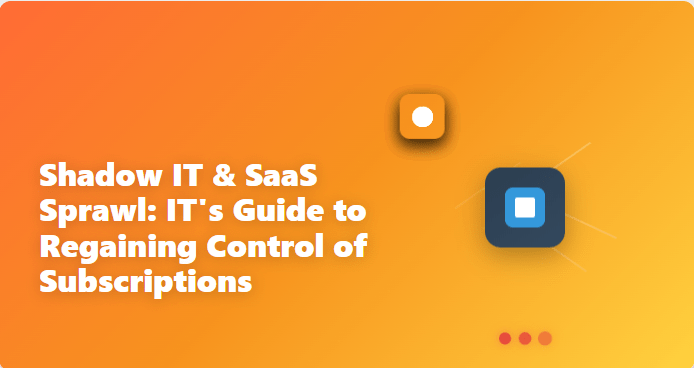
The modern workplace has undergone a digital transformation that has fundamentally changed how organizations consume software. While this evolution has brought unprecedented flexibility and productivity gains, it has also created new challenges that IT departments must navigate carefully. Among the most pressing concerns are Shadow IT and SaaS sprawl—two interconnected phenomena that can undermine organizational security, inflate costs, and complicate compliance efforts.
Shadow IT refers to the use of unauthorized software, applications, and cloud services by employees without explicit approval from the IT department. Meanwhile, SaaS sprawl describes the uncontrolled proliferation of software subscriptions across an organization, often resulting in redundant tools, underutilized licenses, and escalating costs. Together, these issues represent a significant threat to organizational efficiency and security that demands immediate attention from IT leaders.
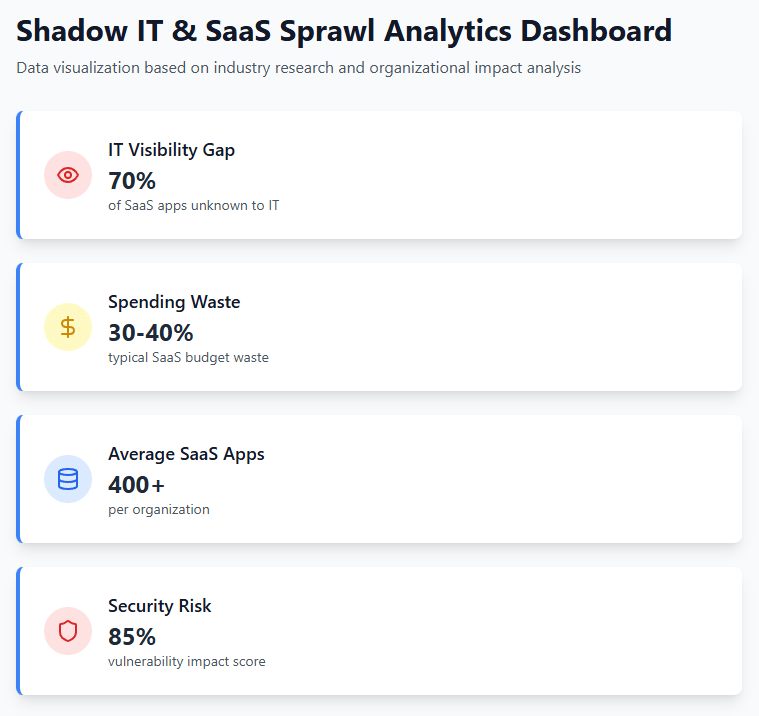
Understanding the Shadow IT Landscape
The rise of Shadow IT isn’t necessarily a result of employee rebellion against IT policies. Instead, it often stems from a genuine need for tools that can help teams work more efficiently. When official procurement processes are slow or when approved solutions don’t meet specific departmental needs, employees naturally seek alternatives that allow them to maintain productivity.
According to recent industry research, the average organization uses over 400 SaaS applications, yet IT departments are typically aware of only about 30% of these tools. This massive blind spot creates vulnerabilities that extend far beyond simple cost concerns. Each unauthorized application represents a potential entry point for cyber threats, a compliance risk, and a data governance challenge.
The democratization of software purchasing has made it easier than ever for employees to sign up for SaaS solutions using corporate credit cards or personal accounts later expensed to the company. While this accessibility has enabled rapid innovation and problem-solving, it has also created a complex web of subscriptions that can be difficult to track and manage effectively.
Cloud-based applications have accelerated this trend because they require minimal technical setup and can be deployed instantly. Unlike traditional software that required IT involvement for installation and configuration, modern SaaS solutions can be operational within minutes of signup, often bypassing established approval workflows entirely.
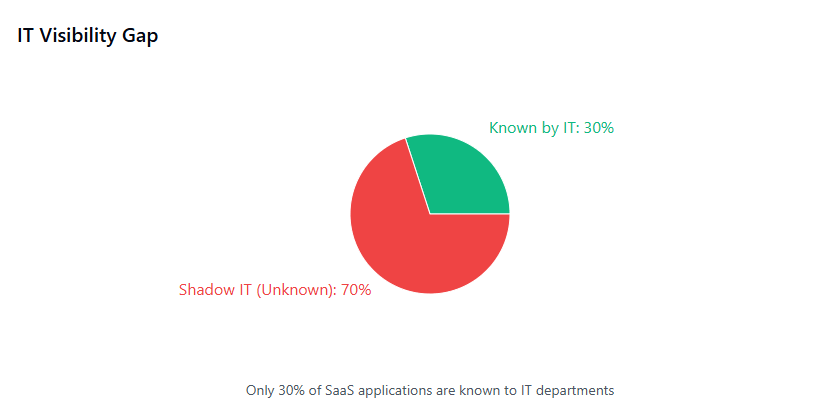
The True Cost of SaaS Sprawl
SaaS sprawl represents more than just a budgeting headache—it’s a multifaceted problem that affects organizations across multiple dimensions. Understanding these impacts is crucial for building a compelling case for implementing stronger controls and governance measures.
Financial Impact and Hidden Costs
The most immediately visible consequence of SaaS sprawl is financial waste. Organizations frequently discover they’re paying for multiple tools that serve similar functions, maintaining subscriptions for departed employees, or carrying licenses that far exceed actual usage requirements. Studies suggest that companies typically waste 30-40% of their SaaS spending due to poor visibility and inadequate cost management.
Beyond direct subscription costs, SaaS sprawl creates hidden expenses through operational inefficiencies. Employees may spend valuable time switching between redundant tools, learning multiple interfaces that accomplish the same tasks, or manually integrating systems that weren’t designed to work together. These productivity losses compound over time, representing a significant opportunity cost for the organization.
The complexity of managing numerous subscriptions also increases administrative overhead. Finance teams must track multiple billing cycles, negotiate with various vendors, and process numerous invoices. IT departments face the challenge of supporting an ever-growing portfolio of applications, each with its own technical requirements and support needs.
Security Vulnerabilities and Compliance Risks
From a security perspective, each unauthorized application represents a potential attack vector. Shadow IT applications often lack the security controls and monitoring that would typically be applied to officially sanctioned tools. This creates blind spots in security monitoring and makes it difficult to maintain comprehensive incident response capabilities.
Data governance becomes particularly challenging when information is scattered across numerous unauthorized platforms. Organizations lose visibility into where sensitive data resides, how it’s being processed, and who has access to it. This fragmentation makes it nearly impossible to ensure compliance with regulations like GDPR, HIPAA, or industry-specific requirements.
The lack of centralized identity management for Shadow IT applications also creates security risks. Employees may use weak or reused passwords, enable insecure sharing settings, or fail to properly configure privacy controls. Without IT oversight, these vulnerabilities can persist undetected until a security incident occurs.
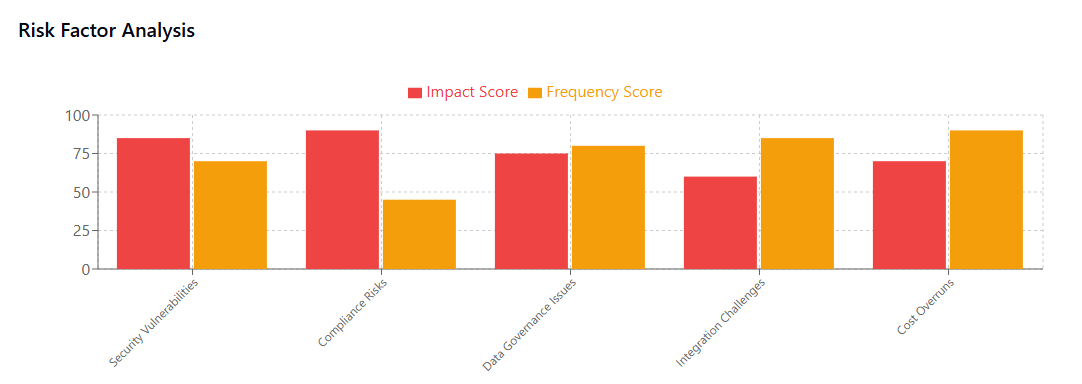
Integration and Data Management Challenges
SaaS sprawl creates significant challenges for data integration and workflow automation. When teams use disparate tools that don’t communicate effectively, it becomes difficult to maintain data consistency or create seamless processes that span multiple applications. This fragmentation can lead to data silos, inconsistent reporting, and decreased operational efficiency.
The proliferation of different data formats, APIs, and integration requirements also complicates technical architecture decisions. IT teams may find themselves supporting numerous point-to-point integrations rather than building cohesive, scalable systems that can adapt to changing business needs.
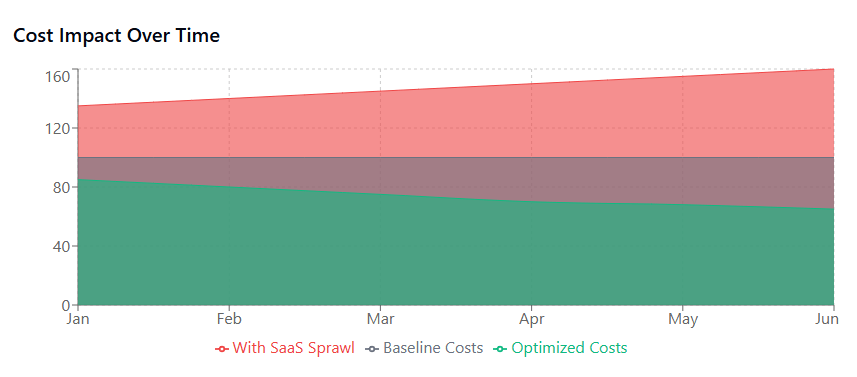
Strategies for Combating Shadow IT
Addressing Shadow IT requires a balanced approach that acknowledges the legitimate business needs driving unauthorized software adoption while implementing controls that protect organizational interests. The most effective strategies combine policy enforcement with improved service delivery and employee education.
Implementing Comprehensive Discovery and Visibility
The first step in regaining control over Shadow IT is gaining visibility into the current state of software usage across the organization. This requires implementing discovery tools and processes that can identify unauthorized applications without disrupting business operations.
Network monitoring tools can help identify cloud applications being accessed from corporate networks, while SaaS management platforms can provide insights into subscription patterns and usage analytics. Financial analysis of credit card statements and expense reports can also reveal unauthorized software purchases that might otherwise go unnoticed.
Regular employee surveys and departmental audits can supplement technical discovery methods by providing context about why specific tools are being used and what business needs they address. This information is crucial for making informed decisions about which applications should be formally approved and which should be replaced with sanctioned alternatives.
Establishing Clear Governance Policies
Effective Shadow IT governance requires clear policies that define acceptable software usage while providing reasonable alternatives for legitimate business needs. These policies should balance security and compliance requirements with the flexibility needed to support innovation and productivity.
Governance frameworks should include clear criteria for software evaluation, approval processes that are efficient enough to compete with self-service alternatives, and regular review cycles that can adapt to changing business requirements. The goal is to make authorized procurement more attractive than unauthorized alternatives by reducing friction and improving responsiveness.
Policy enforcement should be supported by technical controls where possible, such as network-level blocking of high-risk applications or automated monitoring for policy violations. However, these controls should be implemented thoughtfully to avoid creating productivity barriers that might drive employees toward less visible workarounds.
Centralized Procurement and Vendor Management
Implementing centralized procurement processes for SaaS applications can help organizations negotiate better pricing, ensure consistent security controls, and maintain better visibility into their software portfolio. This approach works best when it’s combined with streamlined approval workflows that can respond quickly to legitimate business needs.
Centralized SaaS procurement should include standardized evaluation criteria that consider security, compliance, integration requirements, and total cost of ownership. This ensures that purchasing decisions are made with full awareness of their organizational impact rather than just immediate functional requirements.
Vendor management processes should also address ongoing relationship management, including regular security assessments, performance reviews, and contract renewals. This helps ensure that approved applications continue to meet organizational standards throughout their lifecycle.
Implementing Effective SaaS Spend Management
Controlling SaaS sprawl requires sophisticated spend management capabilities that go beyond simple budget tracking. Organizations need comprehensive visibility into their software portfolio, intelligent analytics to identify optimization opportunities, and automated processes to maintain control as they scale.
Comprehensive Subscription Tracking and Monitoring
Effective SaaS spend management begins with comprehensive visibility into all software subscriptions across the organization. This includes not only officially procured applications but also Shadow IT tools that may be expensed through various channels or paid for with departmental budgets.
SaaS management tools can automate much of the discovery and tracking process by integrating with financial systems, monitoring network traffic, and analyzing user behavior patterns. These platforms can identify duplicate subscriptions, track license utilization, and alert administrators to unusual spending patterns or potential security risks.
Regular auditing processes should complement automated monitoring to ensure that subscription data remains accurate and complete. This includes periodic reviews of credit card statements, expense reports, and departmental budgets to identify any software spending that might not be captured by automated systems.
Rightsizing and Optimization Strategies
Once comprehensive visibility is established, organizations can begin optimizing their SaaS portfolio to eliminate waste and improve efficiency. This process involves analyzing usage patterns, identifying redundancies, and rightsizing subscriptions to match actual needs.
Usage analytics can reveal which applications are underutilized and might be candidates for cancellation or downgrading. Similarly, organizations might discover that multiple departments are using different tools for similar functions and could benefit from standardizing on a single solution.
License optimization should be an ongoing process rather than a one-time activity. Regular reviews can identify opportunities to adjust subscription levels based on changing business needs, seasonal usage patterns, or organizational growth. Automated alerts can help administrators respond quickly to significant changes in usage patterns.
Contract Negotiation and Vendor Relationships
Effective SaaS spend management also involves strategic vendor relationship management that can deliver better pricing and terms. This includes consolidating spending with preferred vendors, negotiating enterprise agreements that provide better value, and establishing clear performance expectations.
Organizations should leverage their aggregate spending power when negotiating with SaaS vendors, particularly when multiple departments are using solutions from the same provider. Volume discounts, extended payment terms, and enhanced support arrangements can all contribute to better total cost of ownership.
Regular vendor performance reviews should assess not only cost but also security, reliability, and business value. This information can inform future purchasing decisions and help organizations maintain a high-quality software portfolio that supports their strategic objectives.

Building a Sustainable Governance Framework
Long-term success in managing Shadow IT and SaaS sprawl requires establishing governance frameworks that can adapt to changing technology landscapes while maintaining control over key organizational risks. This involves creating processes, tools, and cultural changes that support responsible software consumption.
Establishing Cross-Functional Collaboration
Effective SaaS governance requires collaboration between IT, finance, procurement, legal, and business stakeholders. Each group brings unique perspectives and requirements that must be balanced to create sustainable policies and processes.
Regular governance committee meetings can provide a forum for discussing emerging software needs, evaluating new technologies, and making decisions about portfolio changes. These committees should include representatives from key business units to ensure that governance decisions consider operational requirements alongside security and compliance concerns.
Communication channels should be established to help employees understand governance policies and request approval for new software needs. This includes clear documentation of approval processes, criteria for software evaluation, and timelines for decision-making.
Implementing Automated Controls and Monitoring
Technology solutions can help enforce governance policies and provide ongoing monitoring capabilities that scale with organizational growth. This includes automated discovery tools, policy enforcement systems, and analytics platforms that can identify emerging risks or optimization opportunities.
Cloud tagging strategies can help organizations maintain visibility into their software portfolio and automate cost allocation processes. Consistent tagging approaches enable better reporting, more accurate cost tracking, and improved resource management across the entire technology stack.
Integration with existing IT service management (ITSM) systems can help streamline approval workflows and ensure that software requests are properly evaluated and documented. This creates an audit trail that supports compliance requirements while making it easier for employees to request new tools when needed.
Continuous Improvement and Adaptation
SaaS governance frameworks must be designed for continuous improvement and adaptation to changing business needs and technology landscapes. Regular reviews of policies, processes, and tools should identify opportunities for optimization and ensure that governance approaches remain effective over time.
Metrics and key performance indicators (KPIs) should be established to measure the effectiveness of governance initiatives. This might include metrics related to cost savings, security incident reduction, compliance improvements, or employee satisfaction with IT services.
Feedback mechanisms should be implemented to gather input from employees, business stakeholders, and vendors about the effectiveness of governance processes. This information can inform future improvements and help ensure that governance approaches support rather than hinder business objectives.
Technology Solutions for SaaS Management
Modern SaaS management challenges require sophisticated technology solutions that can provide comprehensive visibility, automated controls, and intelligent analytics. Organizations should evaluate their technology stack to ensure they have the capabilities needed to effectively manage their software portfolio.
SaaS Management Platforms and Tools
Dedicated SaaS management platforms can provide comprehensive capabilities for discovering, tracking, and optimizing software subscriptions. These tools typically offer features such as automated discovery, usage monitoring, cost analytics, and workflow automation that can significantly improve management efficiency.
When evaluating SaaS management solutions, organizations should consider factors such as integration capabilities, scalability, security features, and ease of use. The platform should be able to integrate with existing financial systems, identity management tools, and business applications to provide a comprehensive view of the software portfolio.
Cost management tools can help organizations identify spending anomalies, track budget performance, and forecast future costs based on usage trends. These capabilities are essential for maintaining financial control as software portfolios grow and evolve.
Integration with Existing IT Infrastructure
SaaS management solutions should integrate seamlessly with existing IT infrastructure to avoid creating additional silos or management overhead. This includes integration with identity and access management (IAM) systems, security information and event management (SIEM) platforms, and IT service management tools.
Single sign-on (SSO) integration can help improve security while simplifying user management across multiple SaaS applications. This approach provides IT teams with better visibility into user access patterns while improving the user experience for employees.
API-based integrations can enable automated data synchronization between SaaS management platforms and other business systems. This reduces manual effort while ensuring that management information remains accurate and up-to-date.
Automation and Workflow Optimization
Automation capabilities can significantly improve the efficiency of SaaS management processes while reducing the risk of human error. This includes automated subscription provisioning and deprovisioning, usage monitoring and alerting, and cost optimization recommendations.
Workflow automation can streamline approval processes, ensure consistent policy enforcement, and provide audit trails for compliance purposes. This is particularly valuable for organizations with complex approval requirements or strict regulatory obligations.
Machine learning and artificial intelligence capabilities can enhance SaaS management by identifying usage patterns, predicting future needs, and recommending optimization actions. These technologies can help organizations proactively manage their software portfolio rather than simply reacting to problems as they occur.
Best Practices for Long-term Success
Achieving sustained success in managing Shadow IT and SaaS sprawl requires implementing best practices that address both immediate challenges and long-term strategic objectives. These practices should be tailored to the organization’s specific needs while incorporating industry-proven approaches.
Employee Education and Change Management
Successful SaaS governance initiatives require buy-in from employees across the organization. This means investing in education and change management programs that help employees understand the importance of governance policies and provide them with the tools and knowledge needed to comply effectively.
Training programs should cover topics such as security best practices, approved software alternatives, and proper procedures for requesting new tools. Regular communication about governance policies and their benefits can help maintain awareness and compliance over time.
Incentive structures should be aligned to encourage compliance with governance policies while recognizing the legitimate business needs that drive software adoption. This might include recognition programs for departments that effectively manage their software portfolio or streamlined approval processes for teams that consistently follow established procedures.
Regular Auditing and Compliance Monitoring
Ongoing auditing and compliance monitoring are essential for maintaining control over SaaS sprawl and ensuring that governance policies remain effective. Regular audits should assess both compliance with established policies and the effectiveness of those policies in meeting organizational objectives.
Compliance monitoring should be automated where possible to reduce manual effort and ensure consistent application of policies. This includes monitoring for unauthorized software usage, tracking license compliance, and identifying potential security risks.
Audit findings should be used to continuously improve governance processes and policies. This includes identifying gaps in current approaches, updating policies to address new risks or requirements, and refining processes to improve efficiency and effectiveness.
Performance Measurement and Optimization
Organizations should establish clear metrics and KPIs to measure the success of their SaaS governance initiatives. These metrics should cover financial performance, security improvements, operational efficiency, and employee satisfaction to provide a comprehensive view of program effectiveness.
Regular performance reviews should assess progress against established goals and identify opportunities for improvement. This includes analyzing cost savings achieved, security incidents prevented, and operational efficiencies gained through better SaaS management.
Benchmarking against industry standards and best practices can help organizations identify areas where they may be lagging and opportunities to further improve their SaaS management capabilities.
Looking Forward: Future Trends and Considerations
The landscape of SaaS management continues to evolve as new technologies emerge and business practices adapt to changing market conditions. Organizations must stay informed about emerging trends and prepare for future challenges while maintaining effective governance over their current software portfolio.
Emerging Technologies and Their Impact
Artificial intelligence and machine learning technologies are increasingly being integrated into SaaS management platforms to provide more sophisticated analytics and automation capabilities. These technologies can help organizations predict future software needs, identify optimization opportunities, and automate routine management tasks.
Edge computing and distributed architectures may create new challenges for SaaS management as applications become more distributed and complex. Organizations will need to adapt their governance approaches to address these evolving architectural patterns.
The rise of low-code and no-code platforms may accelerate Shadow IT adoption as business users gain the ability to create custom applications without traditional IT involvement. This trend requires careful consideration of governance policies and security controls.
Regulatory and Compliance Evolution
Data privacy regulations continue to evolve and expand globally, creating new compliance requirements for SaaS applications. Organizations must ensure their governance frameworks can adapt to changing regulatory requirements while maintaining operational efficiency.
Industry-specific regulations may impose additional requirements on software selection and management practices. Healthcare, financial services, and other regulated industries must consider these requirements when developing their SaaS governance strategies.
Strategic Planning and Investment
Long-term success in SaaS management requires strategic planning and appropriate investment in people, processes, and technology. Organizations should develop multi-year roadmaps that address current challenges while preparing for future requirements.
Investment in SaaS management tools and capabilities should be balanced against other IT priorities and business objectives. The goal is to create sustainable governance capabilities that support business growth while maintaining appropriate control over costs and risks.
Conclusion
Shadow IT and SaaS sprawl represent significant challenges for modern organizations, but they also present opportunities for improved efficiency, cost control, and security when managed effectively. Success requires a comprehensive approach that combines technology solutions, governance processes, and cultural change to create sustainable management capabilities.
The key to long-term success lies in balancing control with flexibility, ensuring that governance measures support rather than hinder business objectives. Organizations that invest in comprehensive SaaS management capabilities will be better positioned to capitalize on the benefits of cloud-based software while avoiding the pitfalls of uncontrolled sprawl.
By implementing the strategies and best practices outlined in this guide, IT leaders can regain control over their software portfolio, optimize costs, and create governance frameworks that support sustainable growth. The investment in proper SaaS management capabilities will pay dividends through improved security, reduced costs, and enhanced operational efficiency.
As the software landscape continues to evolve, organizations that have established strong governance foundations will be better prepared to adapt to new challenges and opportunities. The time to act is now—waiting only allows Shadow IT and SaaS sprawl to become more entrenched and difficult to address.
Through careful planning, appropriate investment, and commitment to continuous improvement, organizations can transform SaaS sprawl from a liability into a strategic advantage that drives innovation and business success.

